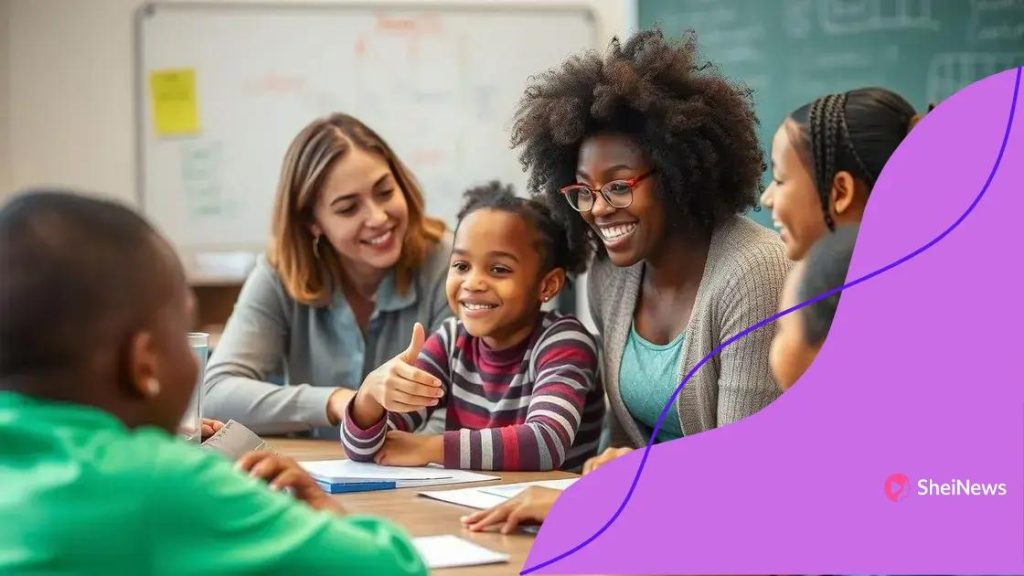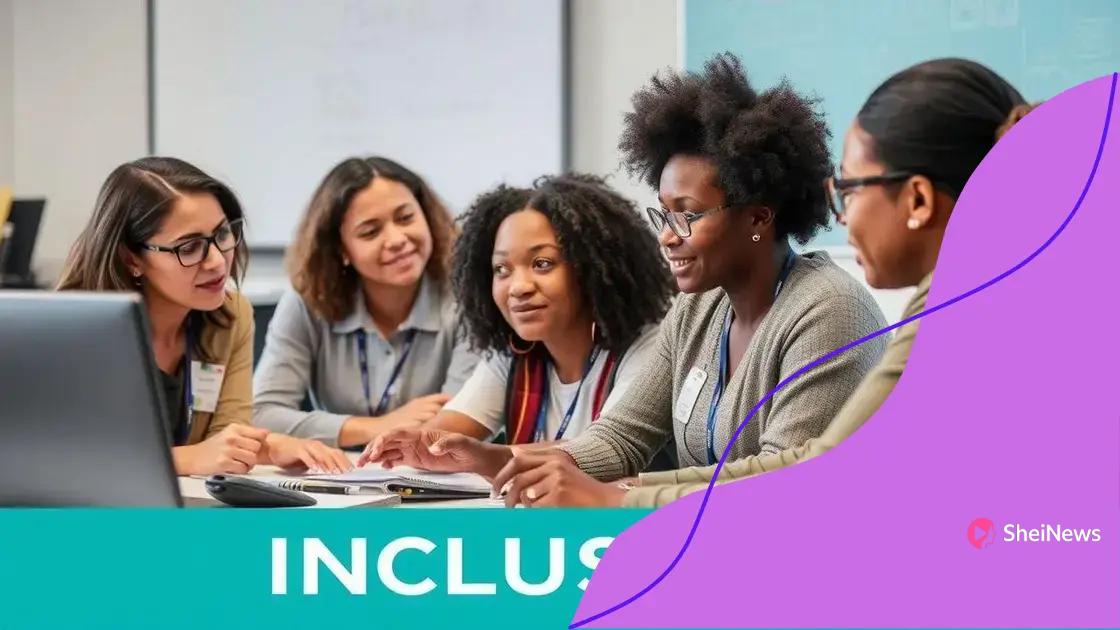Addressing the teacher diversity gap: why it matters

Anúncios
Addressing the teacher diversity gap involves implementing targeted recruitment strategies, creating supportive environments for diverse educators, and promoting inclusive policies to enhance educational equity and improve student outcomes.
Addressing the teacher diversity gap is a pressing issue that influences the quality of education. Have you ever considered how a diverse teaching staff can inspire various learning experiences?
Anúncios
Understanding the teacher diversity gap
Understanding the teacher diversity gap is crucial for improving education. When we discuss this gap, we refer to the difference in the representation of teachers from various backgrounds compared to their student populations. This disparity can affect how students relate to their educators and engage in learning.
Key Concepts of Teacher Diversity
Teacher diversity means having educators from different ethnic, cultural, and socioeconomic backgrounds. This variety can enrich the classroom experience. When students see teachers who look like them or share similar experiences, it fosters a sense of belonging. This connection can significantly enhance learning outcomes.
Factors Contributing to the Gap
Several factors lead to the teacher diversity gap. These include systemic issues within hiring practices and the educational pipeline. Many qualified candidates from diverse backgrounds face barriers that prevent them from entering the teaching profession.
Anúncios
- Limited access to education programs for minority groups.
- Biases in hiring and recruitment processes.
- Lack of mentorship and support for diverse candidates.
We must recognize these challenges and create opportunities. Increasing teacher diversity offers numerous benefits. For one, it can lead to improved academic performance among students of color. Additionally, diverse teaching staff can provide varied perspectives, enriching discussions and critical thinking.
Ultimately, understanding the teacher diversity gap involves looking closely at how we can create an inclusive educational environment. By implementing changes at all levels, we can ensure that every student benefits from a richly diverse learning experience.
The impact of diversity on student outcomes
The impact of diversity on student outcomes is profound and multifaceted. When classrooms reflect the diverse backgrounds of students, everyone benefits. Research shows that diverse teaching staff can lead to better academic performance, increased engagement, and improved social skills.
Academic Performance
Students from various backgrounds often see enhanced academic performance when taught by diverse educators. This occurs because these teachers can relate better to their students and understand their unique challenges. A shared cultural background can create trust, which encourages students to open up and participate more.
- Diverse teachers can provide role models, increasing student motivation.
- Students are more likely to feel comfortable discussing issues relevant to their backgrounds.
- Varied teaching styles can cater to different learning preferences.
Moreover, when students learn in diverse settings, they develop critical thinking and empathy. These skills are essential in a globalized world. They not only improve classroom dynamics but also prepare students for future workplaces.
Social Skills and Engagement
Socially, diversity enhances outcomes as students learn to collaborate with peers from different backgrounds. This exposure fosters respect, understanding, and teamwork. Students who engage in diverse environments develop better communication skills, making them more adaptable in various situations.
In addition, diverse classrooms promote inclusivity. When students feel included, their overall well-being improves. They are less likely to experience feelings of isolation or disengagement. Besides, the classroom discussions become richer and more varied, allowing for multiple viewpoints to be shared.
Ultimately, the impact of diversity on student outcomes is significant. As education continues to evolve, embracing diversity will be key in shaping a brighter future for all learners.
Strategies for increasing teacher diversity

Strategies for increasing teacher diversity are essential for creating a more inclusive educational system. Implementing targeted initiatives can make a significant difference. Schools and districts must actively seek diverse candidates and create supportive environments.
Recruitment Initiatives
One effective way to increase teacher diversity is through focused recruitment efforts. Educational institutions should partner with minority-serving colleges to attract candidates from varied backgrounds. Job fairs aimed specifically at underrepresented groups can also be beneficial. Incorporating diversity goals in hiring processes encourages a broader range of applicants.
- Develop partnerships with local community organizations.
- Create scholarship programs for aspiring teachers from diverse backgrounds.
- Participate in job fairs that emphasize diversity and inclusion.
Moreover, using social media and online platforms can help reach potential candidates who may not have considered teaching as a career. Highlighting success stories of diverse educators can inspire others to follow suit.
Support and Retention
Once diverse educators are hired, it is critical to support and retain them. Providing mentorship programs can help new teachers navigate their roles. Connecting them with experienced educators can build a sense of belonging. Regular professional development opportunities focused on cultural competence also ensure that teachers are prepared to meet the needs of their diverse classrooms.
Creating a welcoming school culture is vital. Schools should celebrate diversity through events and curriculum that reflects various cultures. Encouraging open dialogue about race, culture, and identity fosters an inclusive environment that enhances retention.
Investing in strategies to increase teacher diversity not only improves educational equity but enriches the learning experience for all students. By prioritizing recruitment and support, schools can create a teaching workforce that mirrors their student populations.
Barriers to achieving diversity in education
Barriers to achieving diversity in education can significantly impact the quality of learning. Understanding these obstacles is crucial for implementing effective changes. Many factors contribute to the lack of diversity among teachers and students.
Systemic Issues
One major barrier is systemic issues within educational institutions. Often, hiring practices favor candidates from specific backgrounds, limiting diverse representation. These biases can be subtle yet pervasive, affecting every level of the hiring process. Additionally, admission processes in colleges of education can inadvertently screen out underrepresented groups.
- Lack of outreach to minority communities during recruitment.
- Unconscious biases in resume screening and interviews.
- Limited support for candidates from diverse backgrounds.
Moreover, funding disparities in schools also perpetuate inequality. Schools in low-income areas often lack resources to attract and retain diverse staff. This is crucial because a diverse teaching workforce can help all students succeed.
Cultural and Social Barriers
Cultural barriers also play a significant role. Misunderstandings and lack of awareness about different cultures can lead to an unwelcoming environment. Students and teachers from diverse backgrounds may not feel valued or understood in predominantly homogeneous settings. This can hinder their engagement and performance.
Social barriers, like segregation in neighborhoods, also impact school demographics. Many schools are heavily influenced by the communities around them. If a community lacks diversity, its schools are likely to reflect that absence. This can create a cycle that is hard to break.
Identifying and addressing these barriers is critical in moving towards a more equitable educational system. Schools must recognize these challenges and work collaboratively to create environments that promote diversity.
The role of policy in promoting diversity
The role of policy in promoting diversity is vital in education. Policies can set the tone for schools, guiding how institutions approach diversity and inclusion. Effective policies create a framework that supports the recruitment and retention of diverse educators and students alike.
Creating Inclusive Enrollment Policies
One of the essential ways policy influences diversity is through enrollment practices. Schools must adopt inclusive enrollment policies that encourage students from various backgrounds to apply. This can include outreach programs aimed at underrepresented communities. Adjusting admission criteria to consider diverse experiences can also help.
- Outreach initiatives to encourage minority participation.
- Flexible admission criteria that emphasize holistic evaluation.
- Partnerships with community organizations to boost applications.
When schools actively seek diversity through their enrollment processes, they create a richer learning environment for all students.
Support for Diverse Teachers
Policies that support diverse teachers are equally important. This can involve mentorship programs designed to assist new teachers from underrepresented groups. Additionally, offering professional development opportunities that address issues of race and culture can help foster an inclusive atmosphere in schools.
Providing resources such as workshops and training to improve cultural competence is crucial. These initiatives not only empower diverse educators but also benefit students by creating a more understanding school culture.
Furthermore, policy changes that focus on equal pay and job stability are needed. When policies ensure equitable treatment of teachers, it encourages diverse individuals to enter and remain in the profession. This stability can lead to a more diverse teaching workforce that is better equipped to meet the needs of all students.
In summary, the role of policy in promoting diversity cannot be overstated. By implementing thoughtful policies, educational institutions can create environments where diversity is valued and nurtured, ultimately leading to improved outcomes for both students and teachers.
FAQ – Common Questions about Teacher Diversity in Education
What is the teacher diversity gap?
The teacher diversity gap refers to the difference between the demographics of teachers and their students, which can affect student engagement and learning outcomes.
Why is diversity in teaching important?
Diversity in teaching is important because it helps all students feel represented and valued, leading to better academic performance and social skills.
How can schools improve teacher diversity?
Schools can improve teacher diversity by implementing targeted recruitment strategies, offering mentorship programs, and creating inclusive policies.
What barriers exist to achieving diversity in education?
Barriers include systemic biases in hiring practices, cultural misunderstandings, and lack of resources to support diverse educators.





